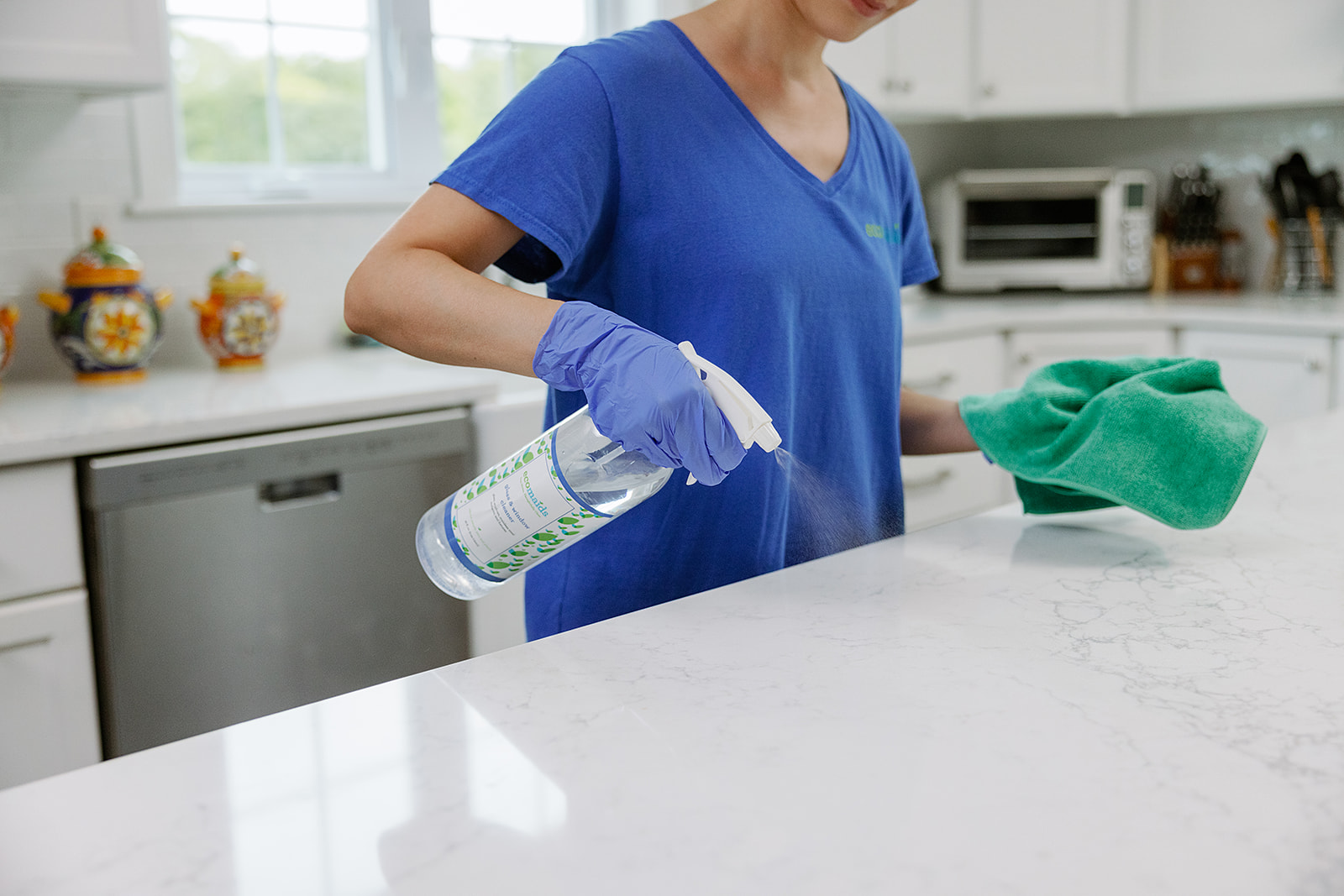Achieve a Cleaner Home with These Everyday Cleaning Tips: Defrosted and Cleaned Every Few Months and More
Wiki Article
Understanding the Need for Completely Disinfecting and Sterilizing Regularly Touched Surface Areas in High-Traffic Areas
In the realm of public wellness and safety and security, the thorough disinfection and sanitization of frequently touched surfaces in high-traffic locations stand as extremely important actions in avoiding the spread of dangerous microorganisms. By checking out the different facets of surface sanitation, from the dangers associated with disregarding cleansing methods to the efficient techniques that can be utilized, a clearer understanding emerges of the vital role these techniques play in protecting public health and wellness.Value of Surface Disinfection
Stressing the comprehensive disinfection of high-traffic surfaces is essential in maintaining a sanitary environment and preventing the spread of unsafe microorganisms. High-touch surfaces such as door takes care of, light buttons, lift buttons, and kitchen counters function as reproducing premises for germs and viruses. Regular disinfection of these surface areas is vital to decrease the threat of contamination and transmission of health problems.By carrying out a robust sanitation procedure, businesses and establishments can produce a more secure setting for site visitors, staff members, and customers. Proper surface area disinfection not only alleviates the spread of infectious diseases yet also imparts self-confidence in the sanitation and safety and security of the facilities. This positive strategy demonstrates a commitment to wellness and wellness, which is especially crucial in high-traffic locations where the likelihood of direct exposure to pathogens is increased.
Additionally, surface area sanitation plays a crucial function in total infection control strategies. Combined with hand hygiene practices, using masks, and preserving physical distancing, detailed sanitation of high-touch surface areas develops a detailed protection versus the transmission of dangerous microbes. Prioritizing surface disinfection is a necessary element of an alternative method to health and wellness in shared areas.
Risks of Disregarding Cleansing Practices
Disregarding thorough sanitation of high-traffic surface areas substantially increases the threat of microbial and viral contamination, posing a major risk to the health and safety of people frequenting these areas. Failure to apply correct cleaning techniques can result in the accumulation and spread of harmful virus, including infections and germs, on frequently touched surface areas such as doorknobs, handrails, elevator switches, and countertops.
Additionally, disregarding the relevance of complete cleaning not only jeopardizes the well-being of people but additionally threatens initiatives to maintain a sanitary and clean atmosphere. It is vital to recognize the value of appropriate disinfection procedures in preventing the spread of infections and securing public wellness.
Reliable Sanitation Techniques
To maintain optimum sanitation and decrease the risk of contamination on high-traffic surface areas, utilizing reliable sanitation methods is necessary. Among one of the most usual and efficient sanitation techniques is utilizing chemical anti-bacterials. These items can vary in toughness and composition, with some targeting specific microorganisms like viruses or microorganisms. It is essential to adhere to the maker's guidelines for proper dilution, call time, and ventilation when making use of chemical anti-bacterials to guarantee their effectiveness - defrosted and cleaned every few months.Another reliable method is making use of UV-C light. UV-C light has actually been revealed to be efficient in eliminating a broad array of microbes by disrupting their DNA structure, thus stopping them from reproducing. It is essential to utilize UV-C light appropriately, guaranteeing that the proper strength and exposure time are applied to accomplish the wanted disinfection outcomes.
Additionally, utilizing steam cleansing as a disinfection technique can be very effective, specifically on surfaces that are heat-resistant. Steam can pass through permeable surface areas and kill germs, viruses, and other pathogens efficiently. When using vapor cleansing, it is very important to ensure that the surface area reaches the needed temperature level for an enough amount of time to ensure correct disinfection.
Impact on Public Health
The upkeep of high standards of sanitation and disinfection on high-traffic surface areas plays an important role in securing public health. Often touched surface areas in areas with high tramp, such as doorknobs, handrails, lift switches, and washroom centers, function as breeding premises for hazardous microorganisms. Falling short to sufficiently decontaminate these surfaces can cause the quick spread of infectious diseases within areas. By carrying out thorough sanitation methods, the risk of transmission of viruses, microorganisms, and other germs can be dramatically reduced.In high-traffic areas like airport terminals, institutions, healthcare facilities, and public transport systems, the impact of strenuous sanitation actions can not be underrated. Prioritizing the sanitization of frequently touched surfaces is an aggressive strategy to advertising public health and boosting the security of individuals in shared rooms.
Executing Normal Cleaning Methods
Immediately instituting and sticking to a constant timetable of cleaning methods is visit their website critical for maintaining the sanitation and security of high-traffic surface areas. Routine cleansing protocols are crucial in protecting against the accumulation of bacteria and pathogens on browse this site often touched surface areas, particularly in locations with high foot web traffic. By carrying out a systematic technique to cleaning, companies can effectively minimize the threat of disease transmission and create a much healthier environment for employees, clients, and the general public.To establish a reliable cleaning routine, it is crucial to determine high-traffic locations that call for constant interest. These areas may include doorknobs, hand rails, elevator switches, restroom facilities, and shared devices. Applying a routine cleaning program that targets these surface areas numerous times a day can significantly decrease the spread of unsafe bacteria and viruses.
Furthermore, using proper cleaner and disinfectants is key to guaranteeing that surfaces are completely sanitized. Normal training of cleaning team on correct cleansing strategies and the importance of adherence to the cleaning schedule is also important in maintaining a hygienic environment. By prioritizing consistent cleaning protocols, companies can advertise the wellness and health of people that engage with these high-traffic surfaces.

Conclusion
In final thought, it is critical to prioritize thorough disinfection and sanitization of regularly touched surfaces in high-traffic areas to protect against the spread of harmful virus and keep public health. Overlooking appropriate cleansing practices can raise the threat of contamination and transmission of conditions. By carrying out routine cleaning protocols and making use of effective sanitation approaches, we can develop a much safer environment for everybody (Clear Out Any Clutter). It is crucial to recognize the value of keeping clean surfaces in high-traffic areas to ensure the well-being of the area.In the world of public wellness and safety and security, the careful disinfection and sanitization of regularly touched surfaces in high-traffic locations stand as vital actions resource in stopping the spread of hazardous virus. By checking out the various aspects of surface area disinfection, from the threats associated with disregarding cleaning methods to the effective techniques that can be employed, a clearer understanding arises of the important duty these methods play in safeguarding public wellness.Additionally, using steam cleansing as a sanitation method can be extremely reliable, especially on surface areas that are heat-resistant. When using steam cleaning, it is vital to guarantee that the surface area gets to the required temperature level for an enough quantity of time to guarantee correct sanitation.
In conclusion, it is essential to prioritize detailed sanitation and sanitization of regularly touched surface areas in high-traffic locations to prevent the spread of harmful virus and preserve public wellness.
Report this wiki page